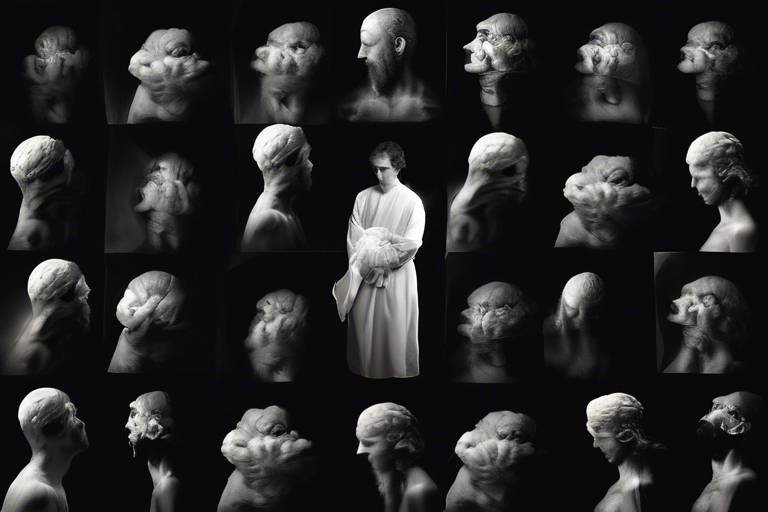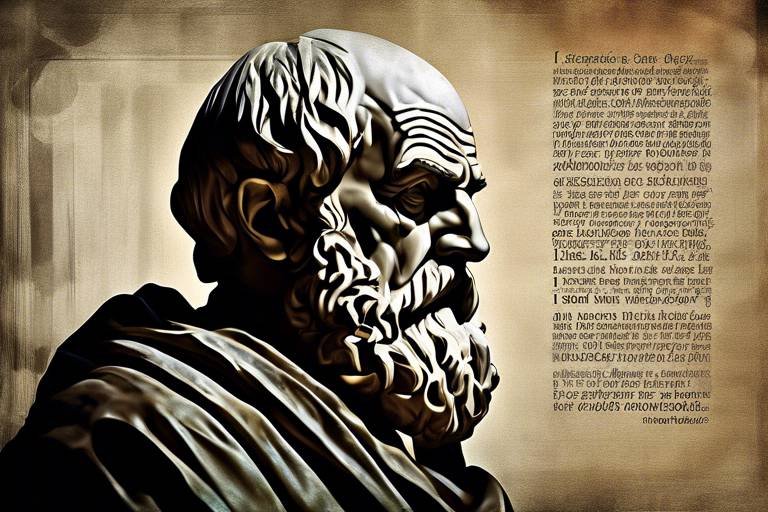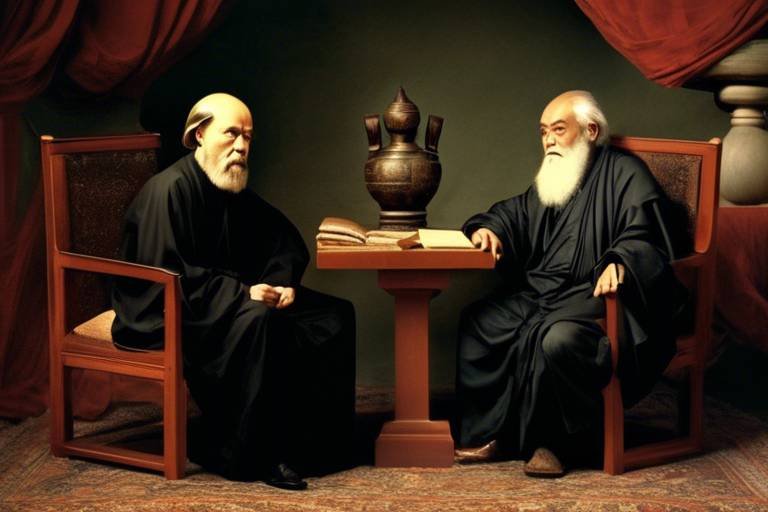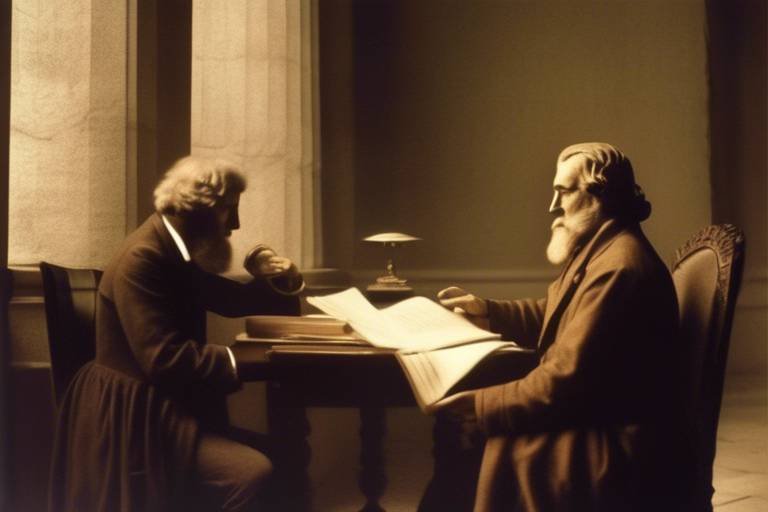Unpacking Derrida's Poststructuralism
In the vast landscape of contemporary philosophy, few figures stand as prominently as Jacques Derrida. His work on poststructuralism has not only reshaped our understanding of language and meaning but has also sparked a revolution in how we interpret texts across various disciplines. So, what exactly is poststructuralism, and why is it such a big deal? Let's dive into the intricate web of ideas that Derrida wove, exploring how they challenge our traditional notions of meaning and interpretation.
At its core, poststructuralism is a reaction against the rigid structures of structuralism, which posited that meanings are stable and can be understood through systematic analysis. Derrida, however, argued that meaning is anything but fixed. Instead, he proposed that meaning is fluid, constantly shifting based on context and the interplay of various signs. Imagine trying to catch a fish in a river; just when you think you have it, it slips away, darting in a new direction. This is how Derrida viewed meaning—always in motion, always elusive.
To fully appreciate Derrida's poststructuralism, we need to consider its historical context. Emerging in the mid-20th century, poststructuralism drew from a rich tapestry of philosophical movements, particularly existentialism and structuralism. These influences shaped Derrida's thinking, leading him to question the very foundations of how we understand texts and the world around us. It’s like peeling back layers of an onion—each layer reveals something new, often surprising.
One of the most significant contributions of Derrida's thought is the concept of deconstruction. This approach encourages us to take a closer look at texts, unveiling the hidden complexities and contradictions within them. Instead of accepting a text at face value, Derrida invites us to question its assumptions and explore the instability of meaning. This is not merely a philosophical exercise; it has profound implications for literature, criticism, and our everyday interactions with language.
In the realm of literature, Derrida's ideas have prompted a reevaluation of how we analyze texts. Traditional literary criticism often sought to extract a singular meaning or moral from a story. However, Derrida's perspective encourages us to consider multiple interpretations, recognizing that each reader brings their own experiences and biases to the text. This is where the concept of intertextuality comes into play. Derrida posited that no text exists in isolation; rather, every text is interconnected with others, forming a vast network of meanings. Understanding one text often requires us to consider its relationship to others, much like how a single note in a symphony contributes to the overall harmony.
Furthermore, Derrida's critique of binary oppositions—such as presence/absence, good/evil, and male/female—reveals how these dualities create hierarchies that limit our understanding. By challenging these binaries, Derrida opens up a more nuanced view of meaning, allowing for a richer interpretation of texts that embraces ambiguity rather than shying away from it.
As we unpack Derrida's poststructuralism, it becomes clear that his ideas are not just theoretical musings; they have real-world implications for how we engage with language, literature, and even our daily lives. By embracing the fluidity of meaning and the interconnectedness of texts, we can foster a more inclusive and dynamic understanding of the world around us.

The Foundations of Poststructuralism
Understanding the roots of poststructuralism involves delving into its historical context and the philosophical movements that shaped Jacques Derrida's thinking. To truly grasp the essence of poststructuralism, one must first recognize the influence of structuralism and existentialism, two pivotal frameworks that set the stage for Derrida's revolutionary ideas. Structuralism, with its emphasis on underlying structures in language and culture, sought to identify the universal laws governing human behavior and thought. Think of it as the skeleton of human knowledge, where everything has a place and purpose. However, Derrida, in his quest for deeper understanding, began to question these fixed structures.
On the other hand, existentialism introduced a more fluid perspective, emphasizing individual experience and the inherent chaos of human existence. It challenged the notion that there are absolute truths or meanings, suggesting instead that meaning is created through personal experience. This tension between the structured and the chaotic became a fundamental backdrop for Derrida's poststructuralism, where he sought to dismantle the very binaries that define our understanding of language and meaning.
At its core, poststructuralism argues that meaning is not a stable entity waiting to be discovered; rather, it is a dynamic interplay of signs that shifts depending on context. Derrida's assertion that “there is nothing outside the text” encapsulates this idea, suggesting that our interpretations are always influenced by the myriad of texts and contexts that surround us. In this light, the act of interpreting becomes a complex dance, where each step is influenced by the surrounding environment, much like a conversation that evolves with each participant's input.
To further illustrate the foundations of poststructuralism, we can consider the following key influences:
| Philosophical Movement | Key Concepts |
|---|---|
| Structuralism | Universal structures, fixed meanings, underlying systems |
| Existentialism | Individual experience, chaos of existence, subjective meaning |
This interplay between structuralism and existentialism creates a fertile ground for poststructuralism to flourish. Derrida's work invites us to reconsider how we approach texts and meaning. Instead of seeking definitive interpretations, we are encouraged to embrace ambiguity and recognize the layers of meaning that texts can hold. Just as a prism refracts light into a spectrum of colors, so too does poststructuralism reveal the multifaceted nature of meaning, urging us to explore the richness of interpretation.
In summary, the foundations of poststructuralism are deeply intertwined with the philosophical currents of its time. By examining the influences of structuralism and existentialism, we can appreciate how Derrida's ideas emerged as a response to the limitations of these frameworks, offering a more nuanced understanding of language, meaning, and interpretation. This exploration sets the stage for a deeper dive into the core concepts of Derrida's thought, particularly the transformative idea of deconstruction.

Deconstruction: A Core Concept
At the heart of Jacques Derrida's philosophy lies the concept of deconstruction, a revolutionary approach that challenges the very foundations of traditional interpretation. Imagine walking into a room filled with mirrors; each reflection distorts reality, creating an endless play of images that never quite align. This metaphor captures the essence of deconstruction, where meaning is not a fixed entity but a fluid interplay of signs that shifts with context and perspective. Derrida invites us to question the assumptions we hold about texts and their meanings, suggesting that what we perceive is often layered with complexities and contradictions.
Deconstruction operates on the premise that language is inherently unstable. Words, while seemingly straightforward, are laden with multiple meanings and interpretations. Derrida famously stated, "There is nothing outside the text," emphasizing that our understanding is always mediated through language. This notion implies that the act of reading is not passive; instead, it is an active engagement where readers bring their own experiences and interpretations to the forefront. For instance, consider a simple sentence like "The cat sat on the mat." To one reader, it may evoke a sense of calm domesticity, while another might see it as a metaphor for confinement. This multiplicity of meanings is what makes deconstruction so powerful and intriguing.
Derrida's approach to textuality reveals that meaning is not a singular truth waiting to be uncovered. Instead, it is a dynamic process shaped by various factors, including cultural context, historical background, and individual reader responses. The act of interpreting a text becomes an exploration of its many layers, where each reading can unveil new insights. This fluidity of meaning encourages a more nuanced understanding of literature, inviting readers to delve deeper into the intricate web of connections that exist within a text.
One of the key elements of deconstruction is intertextuality, the idea that texts do not exist in isolation. Rather, they are part of a larger conversation, interconnected with other works, ideas, and cultural narratives. When we read a text, we inevitably bring to it the knowledge of other texts we have encountered. For example, a novel may allude to historical events, other literary works, or even popular culture, creating a rich tapestry of meaning. To fully grasp a text, one must consider its relationships with these other texts, acknowledging that understanding is a collaborative effort between the reader and the broader literary landscape.
Derrida also critiques the concept of binary oppositions, which are pairs of contrasting terms that have traditionally been used to structure our understanding of the world, such as good/evil, male/female, and presence/absence. He argues that these binaries create hierarchies that limit our understanding and exclude alternative interpretations. By deconstructing these oppositions, Derrida reveals the complexities and ambiguities that lie beneath the surface. For instance, the notion of 'presence' often implies a sense of stability and certainty, while 'absence' suggests a lack or void. However, by examining these terms closely, we can see how they are interdependent and how their meanings can shift based on context.
In summary, deconstruction serves as a powerful tool for examining the intricacies of language, meaning, and interpretation. It encourages readers to embrace uncertainty and complexity, recognizing that the act of understanding is not a straightforward path but a winding journey filled with surprises. As we engage with texts through the lens of deconstruction, we open ourselves to a world of possibilities, where meaning is not merely discovered but actively created.
- What is deconstruction? Deconstruction is a philosophical approach developed by Jacques Derrida that challenges traditional interpretations of texts and emphasizes the fluidity of meaning.
- How does deconstruction affect literary analysis? Deconstruction encourages a more nuanced analysis by revealing the complexities and contradictions within texts, allowing for multiple interpretations.
- What is intertextuality? Intertextuality is the concept that texts are interconnected and that understanding one text often requires considering its relationship to others.
- Why are binary oppositions important in deconstruction? Binary oppositions create hierarchies that limit understanding; deconstruction critiques these binaries to reveal the ambiguities and interdependencies between terms.

Textuality and Meaning
In the realm of poststructuralism, the concept of textuality takes center stage, fundamentally reshaping our understanding of meaning. Jacques Derrida posits that meaning is not a static entity, but rather a dynamic interplay of signs that are in constant flux. Imagine trying to catch a shadow; just when you think you have it pinned down, it slips away, morphing into something else entirely. This metaphor captures the essence of how meaning operates in Derrida's framework. Texts are not isolated artifacts; they are living entities that engage with their surroundings and evolve over time.
Derrida challenges the traditional notion that a text has a single, authoritative meaning. Instead, he argues that meaning is shaped by context, including the historical, cultural, and social factors that surround both the creation and interpretation of a text. For instance, consider a classic novel. The themes and messages it conveys can be perceived differently depending on the reader's background, experiences, and the societal issues at play during their reading. This fluidity is what makes literature a rich field of exploration, allowing for diverse interpretations that breathe life into the text.
Moreover, Derrida introduces the idea of intertextuality, which suggests that texts do not exist in a vacuum. Instead, they are interconnected, with each text referencing, echoing, or responding to others. This web of relationships creates a tapestry of meaning that is intricate and layered. When we read a poem, for example, we might find ourselves recalling another poem or a historical event that resonates with its themes. This interconnectedness not only enriches our understanding but also highlights the limitations of trying to pin down a definitive meaning.
To illustrate this idea, consider the following table that summarizes the key aspects of textuality and meaning in Derrida's philosophy:
| Key Concept | Description |
|---|---|
| Fluid Meaning | Meaning is not fixed; it changes based on context and interpretation. |
| Intertextuality | Texts are interconnected, influencing and reflecting one another. |
| Contextual Influence | Historical and cultural contexts shape the understanding of a text. |
In essence, Derrida's exploration of textuality and meaning invites us to embrace the ambiguity and complexity of language. It encourages us to engage actively with texts, recognizing that our interpretations are just as valid as the author's intent. This approach not only enhances our appreciation of literature but also fosters a deeper understanding of the world around us. So, the next time you dive into a book, remember: you are not just a passive reader; you are a co-creator of meaning, navigating the rich landscape of textuality.

Intertextuality
Intertextuality is a fascinating concept that lies at the heart of Jacques Derrida's poststructuralism. At its core, intertextuality suggests that no text exists in isolation; rather, every piece of writing is interconnected with others, creating a vast web of meanings and interpretations. Imagine a spider’s web, where each strand represents a different text, and the connections between them symbolize the relationships that shape our understanding of literature and language. This perspective encourages us to see texts not merely as standalone works but as part of a larger conversation that spans across time and culture.
Derrida posits that when we engage with a text, we are not only interpreting its words but also navigating through a multitude of references, echoes, and allusions to other texts. This means that understanding a single piece of literature requires us to consider its relationship to a myriad of other works. For example, when reading Shakespeare, one might find connections to modern literature, films, and even historical events. This interconnectedness enriches our interpretation and reveals layers of meaning that might otherwise remain hidden.
Moreover, intertextuality challenges the notion of originality in writing. If every text is a response to or a dialogue with previous texts, then the idea of a completely original work becomes questionable. Instead, we recognize that authors draw upon a reservoir of existing ideas, styles, and themes, weaving them into their narratives. This interplay of texts can be seen in various literary forms, including:
- Allusion: A subtle reference to another work that enriches the meaning.
- Quotation: Directly incorporating another text to create dialogue.
- Parody: Imitating another text to comment on or critique it.
In essence, intertextuality invites readers to become detectives, piecing together clues from various sources to arrive at a deeper understanding of the text at hand. It emphasizes that meaning is not simply derived from the words on the page but is shaped by the intricate network of relationships between texts. This dynamic process of interpretation not only enhances our appreciation of literature but also encourages us to embrace the complexity of meaning in our reading experiences.

Binary Oppositions
When we dive into the world of , we uncover a fascinating layer of Jacques Derrida's poststructuralism. At its core, this concept refers to the way in which meaning is often constructed through pairs of contrasting terms, such as light/dark, good/evil, and male/female. These oppositions are not just simple contrasts; they create a hierarchy where one term is often privileged over the other. For instance, in many cultures, light is associated with knowledge and goodness, while darkness is linked to ignorance and evil. This hierarchical structure limits our understanding and can lead to exclusionary practices.
Derrida challenges this traditional framework by arguing that these binary oppositions are not as stable as they seem. He posits that meaning is fluid and that the relationship between these terms is more complex than a straightforward dichotomy. When we think about language, it becomes evident that words derive their meaning not just from their definitions, but also from their relationships to other words. This interplay creates a web of meanings that are constantly shifting. For example, if we take the terms male and female, their meanings are shaped by cultural contexts, historical changes, and individual experiences.
Moreover, Derrida's critique of binary oppositions encourages us to consider the grey areas in between these extremes. By doing so, we can challenge the rigid categories that often dictate our understanding of identity and experience. This approach has profound implications not only in philosophy but also in fields like literary theory, gender studies, and cultural criticism. It invites us to think beyond the binary and embrace the complexities of human experience.
To illustrate this concept further, consider the following table that outlines some common binary oppositions and their implications:
| Binary Opposition | Privileged Term | Implications |
|---|---|---|
| Light/Dark | Light | Associates knowledge with goodness, while darkness is seen as ignorance. |
| Male/Female | Male | Often privileges masculine traits over feminine, leading to gender inequality. |
| Presence/Absence | Presence | Values what is present and visible, often neglecting the significance of absence. |
By examining these oppositions, we can begin to understand how they shape our perceptions and societal structures. Derrida's work invites us to deconstruct these binaries, revealing the nuances and ambiguities that lie beneath the surface. In doing so, we can cultivate a more inclusive understanding of meaning, one that embraces the richness of diverse perspectives and experiences.

Implications for Literature and Criticism
Derrida's poststructuralism has profoundly reshaped the landscape of literary theory and criticism, inviting scholars and readers alike to reconsider the way they engage with texts. Traditionally, literary analysis focused on extracting a singular, definitive meaning from a work, often prioritizing the author's intent or the historical context of the piece. However, Derrida's philosophy flips this notion on its head, emphasizing that meaning is not only elusive but also constantly in flux. This perspective encourages a more dynamic interaction with texts, where interpretations are not merely valid but also essential to understanding the work as a whole.
One of the most significant implications of Derrida's ideas is the move towards a more pluralistic approach to interpretation. Instead of adhering to a rigid framework that seeks to pin down meaning, critics are now encouraged to explore the myriad ways a text can be understood. This shift has led to the emergence of various critical methodologies that prioritize the reader's experience and the contextual factors influencing interpretation. For instance, the rise of reader-response theory aligns seamlessly with Derrida's views, positing that each reader brings their own unique perspective, shaped by personal experiences and cultural backgrounds, which co-creates the meaning of the text.
Furthermore, Derrida's critique of binary oppositions has opened the door for more nuanced discussions about power dynamics within literature. By challenging the hierarchies that often accompany oppositional pairs—such as good/evil, male/female, and presence/absence—scholars are prompted to explore the interstitial spaces between these binaries. This exploration allows for a richer understanding of characters, themes, and narratives, revealing complexities that might otherwise go unnoticed. For instance, a character traditionally viewed as a villain may be reinterpreted through the lens of their socio-cultural context, leading to a more empathetic understanding of their actions.
Moreover, the implications of Derrida's thought extend beyond just literary analysis; they also influence how we approach cultural criticism. In a world where texts are interconnected, the idea of intertextuality becomes paramount. This concept suggests that no text exists in isolation; rather, each work is a part of a larger tapestry of narratives and discourses. As critics embrace this interconnectedness, they begin to recognize how cultural, historical, and social factors intertwine to shape meaning. This recognition fosters a more holistic approach to criticism, where the analysis of a single text can lead to broader discussions about societal norms, values, and ideologies.
In summary, Derrida's poststructuralism has not only challenged traditional methods of literary interpretation but has also enriched the field by promoting diversity of thought and encouraging a deeper engagement with texts. As we continue to navigate the complexities of literature and criticism, embracing Derrida's insights allows us to appreciate the fluidity of meaning and the richness of diverse interpretations, ultimately leading to a more vibrant and inclusive literary discourse.
- What is poststructuralism?
Poststructuralism is a philosophical movement that emerged in the late 20th century, challenging the idea that language and meaning are fixed. It emphasizes the fluidity of meaning and the role of context and interpretation. - How does Derrida's deconstruction work?
Derrida's deconstruction involves analyzing texts to reveal inherent contradictions and the instability of meaning, encouraging readers to question traditional interpretations. - What is the significance of intertextuality in Derrida's work?
Intertextuality suggests that texts are interconnected, and understanding one text often requires considering its relationship to others, enriching the interpretation process. - How has poststructuralism influenced literary criticism?
Poststructuralism has led to a more pluralistic approach to literary criticism, where multiple interpretations are valued, and the reader's experience is integral to understanding a text.

The Role of Context in Interpretation
When diving into the world of poststructuralism, one cannot overlook the pivotal role that context plays in shaping the meaning of texts. Imagine reading a novel set in the 18th century without considering the social, political, and cultural backdrop of that era. It would be like trying to solve a puzzle with missing pieces. Context provides those essential pieces, allowing readers to grasp the full picture. In Derrida's view, understanding a text is not merely about the words on the page; it involves a rich tapestry of historical and cultural threads that weave together to create meaning.
Context acts as a lens through which we interpret language, highlighting the fact that meanings are not static but rather fluid and dynamic. This idea challenges the notion that a text can be understood in isolation. For instance, consider how the interpretation of Shakespeare's works has evolved over the centuries. Each generation brings its own cultural and historical context to the reading, influencing how the characters and themes are perceived. Thus, context is not just an accessory to interpretation; it is a fundamental component that shapes our understanding.
Moreover, Derrida emphasizes that the reader's response is equally significant in the interpretive process. This leads us to the concept of reader-response theory, which posits that readers actively participate in creating meaning. Each reader brings their own experiences, emotions, and cultural backgrounds to the text, resulting in a multitude of interpretations. This collaborative dance between reader and text is what makes literature so vibrant and alive. The meaning is not fixed; it evolves as readers engage with the work, making context a crucial player in this interaction.
To illustrate the importance of context further, let’s consider a few examples:
- Historical Context: A poem written during a war may evoke feelings of despair and loss that resonate differently with readers who have experienced conflict versus those who have not.
- Cultural Context: A text that explores themes of identity may be interpreted differently by readers from various cultural backgrounds, as their experiences shape their understanding of the narrative.
- Personal Context: A reader’s current life situation, such as a recent loss or a joyous event, can profoundly influence their interpretation of a text, making it a deeply personal experience.
In summary, context serves as the backdrop against which texts are understood and appreciated. It enriches the interpretive process, allowing for a deeper exploration of meaning that goes beyond the surface. Derrida's poststructuralism invites us to embrace this complexity, recognizing that every reading is unique and shaped by the interplay of various contexts. So, the next time you pick up a book, take a moment to consider the myriad factors that influence your understanding. After all, the magic of literature lies in its ability to resonate differently with each reader, creating a mosaic of interpretations that reflect the diverse tapestry of human experience.
- What is the significance of context in poststructuralism?
Context is vital as it shapes the meaning of texts, highlighting the interplay between the reader's experiences and the text itself. - How does reader-response theory relate to Derrida's ideas?
Reader-response theory aligns with Derrida's views by emphasizing that individual interpretations are valid and that meaning is co-created by the reader and the text. - Can meaning be fixed in a text?
No, according to Derrida, meaning is fluid and influenced by various contexts, making it impossible to pin down a definitive interpretation.

Reader-Response Theory
Reader-Response Theory is a fascinating lens through which to view literature, and it aligns beautifully with Jacques Derrida's poststructuralist ideas. At its core, this theory posits that the interpretation of a text is not solely the responsibility of the author but is a dynamic interplay between the reader and the text itself. Imagine reading a book and feeling a rush of emotions, thoughts, and reflections that are entirely your own; that’s the magic of Reader-Response Theory. It emphasizes that every reader brings their unique background, experiences, and emotions to the reading experience, which in turn shapes the meaning of the text.
In essence, this theory challenges the notion of a singular, objective meaning. Instead, it embraces the idea that meanings are fluid and can change depending on who is reading the text. Just like how a song can resonate differently with each listener, a literary work can evoke a myriad of interpretations. This concept is particularly important in a poststructuralist framework, where the instability of meaning is a central theme. Derrida himself might argue that each reading is a new creation, a unique interpretation that reflects the reader's individual context and perspective.
Moreover, Reader-Response Theory encourages us to consider the following aspects:
- Personal Experience: Each reader’s background can significantly influence how they interpret a text. For instance, a reader who has experienced loss may interpret a poem about grief more profoundly than someone who has not.
- Emotional Engagement: The feelings a reader experiences while engaging with a text can alter their understanding of it. A thrilling plot twist might evoke excitement, leading to a different interpretation compared to a calm, reflective reading.
- Contextual Influence: The time and place in which a reader engages with a text can also affect their interpretation. A contemporary reader might view a classic novel through a modern lens, bringing new insights to age-old themes.
To illustrate this theory further, let’s consider a simple table that outlines how different readers might interpret the same text:
| Reader | Interpretation |
|---|---|
| Reader A | Sees the protagonist's journey as a metaphor for personal growth. |
| Reader B | Interprets the text as a critique of societal norms. |
| Reader C | Focuses on the emotional turmoil depicted in the narrative. |
This table exemplifies how varied interpretations can emerge from the same text, reinforcing the idea that meaning is not fixed. It’s essential to recognize that Reader-Response Theory does not diminish the text's value or the author's intent; rather, it enriches the reading experience by inviting multiple perspectives and interpretations. In a world where we often seek definitive answers, embracing the ambiguity of literature can be both liberating and enlightening.
In conclusion, Reader-Response Theory beautifully complements Derrida's poststructuralism by highlighting the active role of the reader in creating meaning. It reminds us that every reading experience is unique, shaped by our individual contexts and emotions. So, the next time you dive into a book, remember that your interpretation is just as valuable as the author's original intent, and that’s what makes literature a vibrant and ever-evolving art form.

Historical and Cultural Contexts
When diving into the world of Derrida's poststructuralism, one cannot overlook the immense influence of historical and cultural contexts on the interpretation of texts. Think of a text as a time capsule, encapsulating not just words, but the very essence of the era and culture from which it emerged. Each text carries the weight of its surroundings, the social dynamics, and the philosophical currents that were prevalent at the time of its creation. This is where Derrida's insights shine, as they encourage readers to peel back the layers and examine the intricate web of influences that shape meaning.
For instance, consider how a novel written during the Victorian era reflects the societal norms and values of that time. The themes of morality, class, and gender roles are not merely incidental; they are woven into the fabric of the narrative. By understanding the historical backdrop, readers can engage with the text on a deeper level, uncovering nuances that might otherwise remain obscured. Derrida encourages this exploration, suggesting that the context in which a text is produced is as significant as the text itself.
Moreover, cultural contexts add another layer of complexity. A text can be interpreted differently depending on the cultural lens through which it is viewed. For example, a work of literature that addresses themes of identity and belonging might resonate differently with readers from diverse backgrounds. This multiplicity of interpretations underscores Derrida's assertion that meaning is not static but is constantly evolving, shaped by the interplay of various contexts.
To illustrate this point, let’s consider a few key factors that contribute to the historical and cultural contexts of a text:
- Historical Events: Major events such as wars, revolutions, or social movements can profoundly impact a writer's perspective and the themes they choose to explore.
- Cultural Norms: The societal values and beliefs prevalent at the time of writing can influence character development and plot progression.
- Philosophical Trends: The dominant philosophical ideas, such as existentialism or feminism, can shape the narrative structure and thematic focus of a work.
By engaging with these elements, readers can appreciate the rich tapestry of meaning embedded within a text. Derrida posits that to truly understand a work, one must consider not just the words on the page, but the myriad of influences that inform its creation. This holistic approach to interpretation invites readers to become active participants in the meaning-making process, fostering a dialogue between the text, its author, and the cultural milieu.
In conclusion, the historical and cultural contexts surrounding a text are not mere footnotes; they are integral to the understanding of its meaning. Derrida's poststructuralism encourages us to embrace this complexity, recognizing that each reading is a unique interplay of the text, the reader, and the world around them. So, the next time you pick up a book, ask yourself: what stories does it tell beyond the words? What echoes of history and culture can be discovered within its pages?
- What is poststructuralism? Poststructuralism is a philosophical movement that emerged in the late 20th century, challenging the idea of fixed meanings and emphasizing the fluidity of interpretation.
- How does Derrida's deconstruction work? Deconstruction involves analyzing texts to reveal underlying assumptions, contradictions, and the instability of meaning, ultimately questioning traditional interpretations.
- Why is context important in literary interpretation? Context shapes the meaning of texts, as it encompasses historical, cultural, and social factors that influence both the creation and reception of literature.
- What are binary oppositions? Binary oppositions are pairs of contrasting concepts (like good/evil, male/female) that Derrida critiques for creating hierarchies and limiting understanding.

Critiques and Limitations of Poststructuralism
While Jacques Derrida's poststructuralism has undoubtedly reshaped contemporary thought, it has also faced its fair share of critiques. One of the primary concerns raised by critics is the notion of relativism inherent in Derrida's philosophy. By positing that meaning is not fixed but rather fluid and context-dependent, some argue that this perspective undermines the possibility of objective analysis. If meanings can shift based on individual interpretations or cultural contexts, can we truly arrive at a definitive understanding of a text? This question looms large in academic circles, prompting debates about the validity of interpretations drawn from Derrida's framework.
Moreover, detractors contend that poststructuralism's emphasis on ambiguity and multiplicity can lead to a kind of intellectual paralysis. When every interpretation is considered equally valid, it raises the question of whether any interpretation holds more weight than another. This situation can create a sense of confusion, where the reader is left navigating a labyrinth of meanings without a clear path. Critics often point to the potential dangers of this approach, suggesting it may lead to an overabundance of interpretations that dilute the significance of the original text.
To illustrate these critiques, consider the following table that summarizes key concerns regarding poststructuralism:
| Critique | Description |
|---|---|
| Relativism | The rejection of fixed meanings raises questions about objective analysis. |
| Intellectual Paralysis | An overabundance of interpretations can lead to confusion and a lack of clarity. |
| Practical Application | Challenges in applying poststructuralist theory to real-world situations. |
Despite these critiques, proponents of Derrida's philosophy offer compelling responses. They argue that the richness of multiple interpretations is not a weakness but rather a strength, inviting deeper engagement with texts. This embrace of ambiguity allows for a more nuanced understanding of literature, one that acknowledges the complexities of human experience and the myriad ways in which we construct meaning. By recognizing that our interpretations are shaped by our unique contexts, we can appreciate the diversity of perspectives that literature brings to the table.
In conclusion, while the critiques of poststructuralism highlight important concerns regarding relativism and clarity, they also open the door to a richer dialogue about the nature of meaning. Derrida's work invites us to challenge traditional notions of interpretation and embrace the complexities of language and discourse. As we navigate this intricate landscape, we find that the journey itself can be as enlightening as the destination.
- What is the main idea behind Derrida's poststructuralism?
Derrida's poststructuralism emphasizes that meaning is not fixed but fluid, shaped by context and the interplay of signs within a text. - How does deconstruction challenge traditional interpretations?
Deconstruction reveals the instability of meaning within language, questioning the binary oppositions and hierarchies that limit understanding. - What are the implications of poststructuralism for literary criticism?
Poststructuralism encourages a reevaluation of how texts are analyzed, promoting multiple interpretations and reader-response theories. - What critiques exist regarding poststructuralism?
Critics argue that its relativism undermines objective analysis and can lead to confusion due to an overabundance of interpretations. - How do supporters of poststructuralism respond to these critiques?
Supporters emphasize the richness of diverse interpretations and the value of embracing ambiguity in understanding texts.

Challenges to Objectivity
One of the most significant challenges posed by Derrida's poststructuralism is its inherent skepticism toward the notion of objective truth. Critics argue that by rejecting fixed meanings, Derrida's philosophy creates a slippery slope where any interpretation can be justified, leading to a sort of interpretative chaos. Imagine trying to navigate a maze where the walls keep shifting; this is akin to the literary landscape in a poststructuralist framework. The absence of a stable reference point can make it difficult for scholars and readers alike to arrive at a consensus about a text’s meaning.
Moreover, this challenge to objectivity raises questions about the reliability of literary criticism itself. If every reader brings their own experiences and biases to a text, how can we trust any interpretation? Some critics suggest that this relativism undermines the authority of literary analysis, making it seem arbitrary. For example, consider a classic novel like Pride and Prejudice. A feminist reading might highlight themes of gender inequality, while a Marxist interpretation could focus on class struggles. Both perspectives are valid, yet they can lead to conflicting conclusions about the text’s core message. This multiplicity of interpretations is both a strength and a weakness of poststructuralism.
Additionally, the challenges to objectivity can lead to a sense of disillusionment among readers and scholars who seek definitive answers. The fear is that without a common ground, discussions about literature may devolve into mere opinion-sharing sessions rather than rigorous analyses. This is particularly concerning in academic settings where the goal is often to uncover deeper meanings and truths. The table below illustrates some common critiques regarding the challenges to objectivity in poststructuralist thought:
| Critique | Description |
|---|---|
| Lack of Consensus | The absence of fixed meanings leads to divergent interpretations, making it difficult to reach agreement. |
| Arbitrariness of Interpretation | Interpretations may seem arbitrary, as any reading can be justified, reducing the authority of literary criticism. |
| Disillusionment | Readers and scholars may feel disillusioned by the lack of definitive answers, leading to a decline in rigorous analysis. |
Despite these challenges, it's essential to recognize that the richness of multiple interpretations can also be seen as a strength. Proponents of Derrida's philosophy argue that embracing ambiguity allows for a more profound engagement with texts, encouraging readers to explore various perspectives. Ultimately, while the challenges to objectivity in poststructuralism raise valid concerns, they also invite a more dynamic and inclusive approach to literary interpretation.
- What is poststructuralism? Poststructuralism is a philosophical movement that emerged in the mid-20th century, challenging the ideas of fixed meanings and objective truths in language and texts.
- How does Derrida's deconstruction work? Deconstruction involves analyzing texts to reveal the inherent instability of meaning, showing how language can shift and change based on context.
- What are binary oppositions? Binary oppositions are pairs of contrasting concepts (like good/evil, male/female) that Derrida critiques for creating hierarchies and limiting understanding.
- Can poststructuralism be applied to all texts? Yes, poststructuralism can be applied to a wide range of texts, encouraging readers to explore various interpretations and meanings.

Responses to Criticism
In the face of criticism, proponents of Jacques Derrida's poststructuralism stand firm, emphasizing the richness and depth that multiple interpretations bring to texts. They argue that rather than undermining understanding, the absence of fixed meanings allows for a more dynamic engagement with literature and philosophy. This perspective invites readers to explore the **complexity** of language and meaning, suggesting that embracing ambiguity can lead to profound insights.
Critics often express concern that Derrida's rejection of definitive meanings leads to a kind of **intellectual chaos**, where anything can be interpreted in any way. However, defenders of Derrida argue that this very fluidity is what makes literature and philosophy vibrant and relevant. They assert that the **interplay of meanings** can illuminate aspects of a text that might otherwise remain hidden. By allowing for diverse interpretations, readers can engage with texts on a more personal level, creating a dialogue that enriches their understanding.
Moreover, Derrida's supporters contend that the **contextual nature of meaning** does not equate to a lack of meaning. Instead, they argue that it highlights the importance of context—historical, cultural, and personal—in shaping our interpretations. By acknowledging that our experiences and backgrounds influence how we read, we open ourselves to a broader spectrum of understanding. This approach fosters a sense of **community** among readers, as diverse perspectives can lead to more robust discussions.
In response to the critique of relativism, Derrida's advocates often point out that the multiplicity of meanings does not imply that all interpretations are equally valid. Instead, they argue for a **nuanced understanding** of texts, where interpretations can be evaluated based on their coherence and ability to shed light on the text's complexities. This is where the art of criticism comes into play, as critics must navigate the delicate balance between subjective interpretation and textual evidence.
Ultimately, the responses to the criticisms of poststructuralism highlight a fundamental belief in the **power of language** and its capacity to evoke varied interpretations. By embracing the ambiguity and fluidity of meaning, readers and critics alike can engage more deeply with texts, uncovering layers of significance that contribute to a richer understanding of literature and philosophy. In this way, Derrida's poststructuralism not only challenges traditional notions of meaning but also invites us to celebrate the **diversity** of thought and interpretation.
- What is poststructuralism?
Poststructuralism is a philosophical movement that emerged in the late 20th century, emphasizing the instability of meaning and the importance of context in interpretation. It challenges the idea that texts have fixed meanings.
- How does Derrida's deconstruction work?
Derrida's deconstruction involves analyzing texts to reveal the inherent contradictions and ambiguities within them, showing that meaning is shaped by various factors, including cultural and historical contexts.
- Why is context important in interpretation?
Context is crucial because it influences how we understand a text. Historical, cultural, and personal backgrounds shape our interpretations, leading to a richer engagement with the material.
- What are some criticisms of poststructuralism?
Critics argue that poststructuralism's rejection of fixed meanings can lead to relativism, making it challenging to establish objective analyses of texts. Some fear it may result in an overwhelming number of interpretations that lack coherence.
Frequently Asked Questions
- What is poststructuralism?
Poststructuralism is a philosophical movement that emerged in the late 20th century, challenging the ideas of structuralism. It emphasizes the instability of meaning and the complex interplay of language, context, and interpretation. Think of it as a way of looking at texts and meanings that breaks down traditional boundaries, making room for multiple interpretations.
- Who is Jacques Derrida?
Jacques Derrida was a French philosopher and a key figure in poststructuralism. He is best known for developing the concept of deconstruction, a method of analyzing texts that reveals the fluidity of meaning and the interconnectedness of language. Derrida's work invites readers to question established interpretations and consider how context influences understanding.
- What is deconstruction?
Deconstruction is a critical approach that seeks to uncover the assumptions and contradictions within a text. Rather than accepting a single, fixed meaning, deconstruction reveals how meanings can shift based on context and reader interpretation. It's like peeling back the layers of an onion, exposing the complexities and nuances that lie beneath the surface.
- How does intertextuality relate to Derrida's thought?
Intertextuality refers to the idea that texts are interconnected and that understanding one text often requires considering its relationship to others. Derrida argued that no text exists in isolation; instead, each text is shaped by its connections to other works, creating a rich tapestry of meaning that transcends singular interpretations.
- What are binary oppositions, and why does Derrida critique them?
Binary oppositions are pairs of contrasting concepts, such as good/evil or male/female, that have traditionally been used to structure thought. Derrida critiques these oppositions because they create hierarchies that limit understanding and exclude alternative perspectives. By challenging these binaries, Derrida encourages a more nuanced view of meaning that embraces complexity.
- How does context influence interpretation in poststructuralism?
In poststructuralism, context is crucial for understanding a text's meaning. It shapes how we interpret language and reveals layers of significance that might otherwise remain hidden. Just as the same song can evoke different feelings depending on where and when you hear it, the context surrounding a text can dramatically alter its interpretation.
- What is reader-response theory?
Reader-response theory aligns with poststructuralism by emphasizing that individual interpretations of a text are valid. It posits that meaning is co-created by the reader and the text, suggesting that each reader brings their own experiences and perspectives to the interpretation process. It's like a dance between the reader and the text, where both play an active role in creating meaning.
- What are some critiques of poststructuralism?
Critics of poststructuralism often argue that its rejection of fixed meanings leads to relativism, making it difficult to establish objective analyses of texts. They express concerns that this ambiguity could undermine the validity of interpretations. However, proponents of Derrida's philosophy argue that embracing multiple interpretations enriches our understanding of texts.
- How do proponents respond to critiques of poststructuralism?
Proponents of poststructuralism respond to critiques by highlighting the value of multiple interpretations and the richness that ambiguity brings to understanding texts. They argue that rather than diminishing meaning, this approach opens up new avenues for exploration and appreciation of literature and discourse, allowing for a more dynamic engagement with language.



















